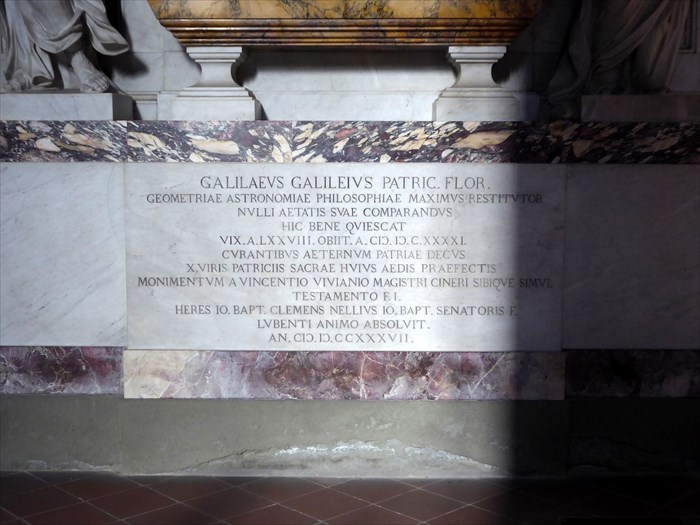
Galileo di Vincenzo Bonaulti de Galilei - Florence, Italy
Posted by:  neoc1
neoc1
N 43° 46.121 E 011° 15.714
32T E 682050 N 4848667
The remains of the preeminent Italian scientist and author Galileo Galilei are located on the wall of the Basilica of Santa Croce in Florence, Italy.
Waymark Code: WM11WN5
Location: Toscana, Italy
Date Posted: 12/30/2019
Views: 3
The polychrome marble tomb of Galileo was sculpted by Giulio Foggini between 1734 and 1737. It contain a white marble sculpture of the Italian scientist whose writings literally changed the way we understand the world. The brown and black marble tomb is flanked by two allegorical sculptures of robed female figures representing Astronomy by Vincenzo Foggini, and Geometry by Girolamo Ticciati.
Below is a Latin inscription noting his contribution to the world in geometry, astronomy, and philosophy (science).

Summary: Galileo Galilei, Florentine patrician, the greatest restorer of Geometry, Astronomy and Philosophy to be compared to none of his era, may rest well in this place.
Lived 78 years - Died in 1642.
Galileo was born in Pisa, Duchy of Florence on February 15, 1564. He was a leading figure in the Renaissance and he is considered to be the "father of observational astronomy", the "father of modern physics", the "father of the scientific method",and the "father of modern science". In his famous experiment from the Tower of Pisa he proved that falling objects fall at the same speed regardless of their weight. He also was first to use a telescope to systematically study the sky and discovered the then heretical fact that four moons circle the planet Jupiter.
Galileo's writings included:
A study of the balance (La Billancetta) describing an accurate balance to weigh objects in air or water and the manual on the operation of a geometrical and military compass (Le Operazioni del Compasso Geometrico et Militare). His work in dynamics was published in On Motion (Pisan De Motu) and on mechanics (Paduan Le Meccaniche).
His masterwork The Starry Messenger reported the discovery of four moons orbiting Jupiter that revolutionized man's view of his place in the universe. His 1623 publication The Assayer (Il Saggiatore), challenged the theories of Aristotle, promoted experimentation, and the mathematical formulation of scientific ideas. In 1563 he wrote Dialogue Concerning the Two Chief World Systems, a defense of his astronomical discoveries for which he nearly was excommunicated from the Roman Catholic Church. He publicly recanted his views before the Inquisition but privately retained them. He was exonerated by the Roman Catholic Church in 1992.
He died in Arcetri, Grand Duchy of Tuscany on January 8, 1642 at age 77.